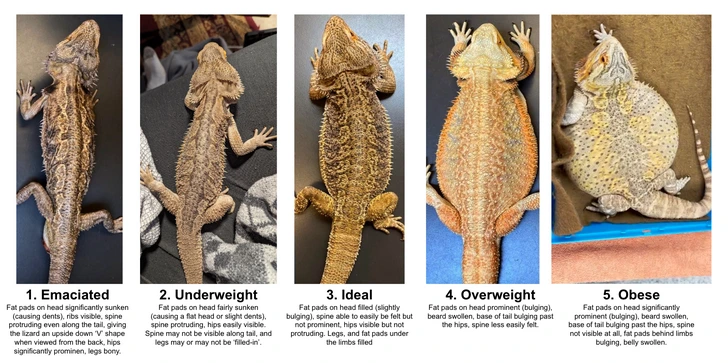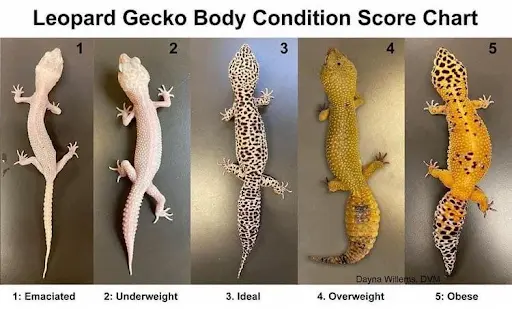Making Adjustments to Your Pet's Feeding Schedule
Every animal is different. While our subscriptions provide a much better starting point than most recommendations, it’s still a good idea to make slight adjustments to your provided feeding schedule. Here are some reasons you might want to consider making adjustments:
- Your pet is toward the younger or older range of your subscription age class.
- Your pet is naturally smaller or larger than other individuals of their age.
- Your pet is very active or very inactive.
- Your pet needs some help with weight management.
Before making adjustments, first consider your reasons for making the change. Don’t trust your pet’s appetite alone. Almost all pets will seem hungry and ‘beg’ for more food—it’s just in their nature!
What we'll cover
General Recommendations
If you think your pet needs a little less food, feed 1-4 fewer insects each feeding, or skip 1-2 feedings per week. If you think your pet needs a little more food, feed 1-4 more insects each feeding.
If your pet is moderately active and not over or underweight, the calculator below does an excellent job of providing a base recommendation. Keep in mind that this recommendation is intended to maintain your dragon’s body mass. If your animal needs help with weight management, it will not provide an accurate estimate, and you will need to adjust it further. Interestingly, the calculator is still fairly accurate for growing animals of a healthy body weight.
Recommended Workflow to Dial in Your Pet's Schedule
- Weigh your animal and use the recorded weight in combination with the calculator to assess if our standard feeding schedule needs any adjustments.
- Assess your animal’s current body condition and determine if further adjustments are needed:
- If at a healthy weight and body condition, very minor adjustments should be needed.
- If at a suboptimal body condition, follow the above recommendations as a starting point to adjust the calculator’s suggested feeding amount.
- Record and track your animal’s weight weekly, along with visual inspections of their body condition.
- Continue to fine-tune and make adjustments as needed.
The good news is that by using a more science-based approach, you are already much more likely to have a nearly perfect feeding schedule. With some attention to detail, you can customize it to give your pet exactly what they need.
Bearded Dragons
Bearded Dragon Feeding Calculator
Results
Below is an estimate of the number of insects needed to meet your dragon’s insect calorie requirement per feeding—if you were to rely on just one type of feeder. This is only an illustration; you don’t need to feed all of these, just choose the feeder(s) that work best for your dragon.
| Insect Type | Estimated Quantity per Feeding | Total Insect Weight (g) |
|---|
The first and most important part of making adjustments is considering your bearded dragon’s current age and body condition. You can also consider your pet’s setup and activity level. Our feeding schedules are designed to feed a properly housed and active pet. If your pet is kept in a smaller-than-recommended enclosure, or is otherwise not very active, our feeding schedule likely recommends too much food. The best way to determine this is by assessing their body condition weekly and making small adjustments to their feeding schedule as required.
For animals on the lower end of your subscription’s age range, we recommend decreasing the number of insects per feeding by 1-2 for superworms and Dubia Roaches, and by 5-7 for BSFL.
For animals on the higher end of your subscription’s age range, we recommend increasing the number of insects per feeding by 1-2 for superworms and Dubia Roaches, and by 5 for BSFL. It’s important to be cautious whenever increasing your feeding quantity. Keep a close eye on your animal’s body condition and adjust accordingly.
The chart below describes various body conditions. Give your dragon a close look and determine where they fall. If their weight needs adjustment, refer to the top section for recommendations. Keep a close eye on things and continue to make adjustments until their body condition improves.
For sub-adult and adult animals, body condition will become more important and sensitive as their growth slows.
If you have concerns over your pet’s body condition, or would like personalized information, we recommend you speak with a registered vet.

Leopard Geckos
Leopard Gecko Calories Calculator
Results
| Insect Type | Estimated Quantity Needed | Total Weight (grams) |
|---|
The first and most important part of making adjustments is considering your leopard gecko’s current age, and body condition. You can also consider your pet’s set up and activity level. Our feeding schedules are designed to feed a properly housed and active pet. If your pet is kept in a smaller than recommend enclosure, or is otherwise not very active, our feeding schedule likely recommends too much food. The best way to determine this is by assessing their body condition weekly, and making small adjustments to their feeding schedule as required.
For animals on the lower end of the your subscriptions age range, we recommend decreasing the number of insects per feeding by 1-2 for superworms and Dubia Roaches and by 2-3 for BSFL.
For animals on the higher end of your subscriptions age range, we recommend increasing the number of insects per feeding by 1-2 for superworms and Dubia Roaches and by 2-3 for BSFL. It’s important to be cautious whenever increasing your feeding quantity. Keep a close eye on your animals body condition and adjust accordingly.
The below chart describes various body conditions. Give your gecko a close look and determine where they fall. If their weight needs adjustment, refer to the above section for recommendation. Keep a close eye on things and continue to make adjustments until their body condition improves.
For sub-adult and adult animals, body condition will become more important and sensitive as their growth slows.
If you have concerns over your pet’s body condition, or would like personalized information, we recommend you speak with a registered vet.

